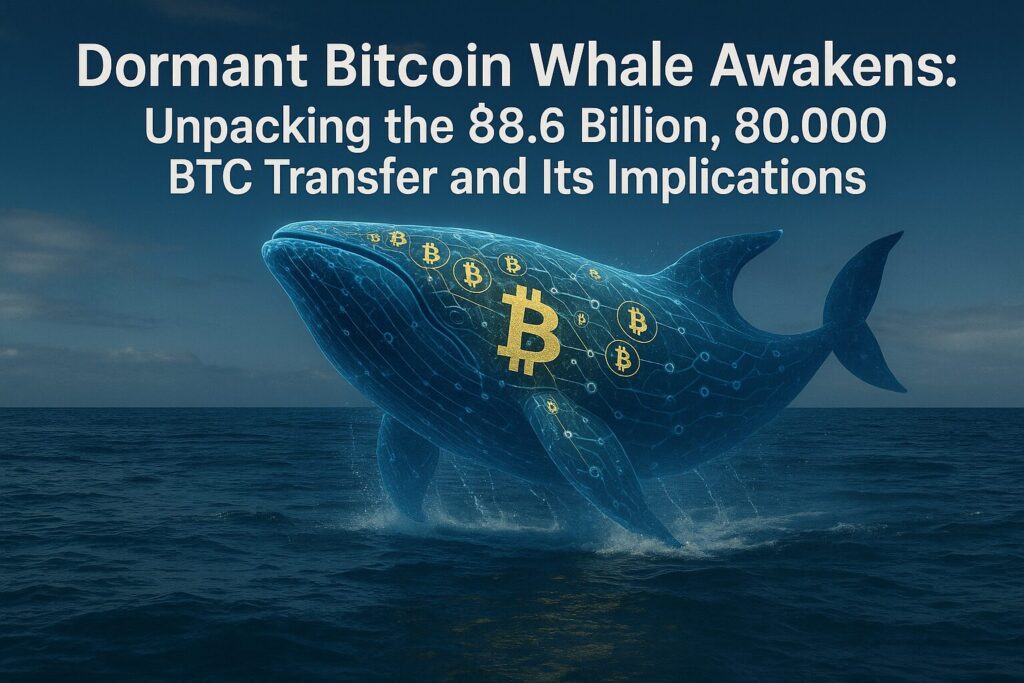
Main Points :
- Historic Scale: 80,000 BTC (~ $8.6 billion) moved from 14-year-dormant wallets on July 4, 2025, the largest single transfer of decade-old coins in Bitcoin history.
- Single Entity Operation: Blockchain-analysis firm Arkham Intelligence attributes the entire movement to one entity, executed in five transactions over 10 hours.
- Hack Speculation vs. Security Upgrade: Coinbase’s Conor Grogan labeled the pattern “extreme speculation” but noted a preceding Bitcoin Cash test transfer could indicate foul play.
- Community Pushback: Analysts and developers argue that modern Bitcoin is mathematically secure against key-cracking, and the slow pace suggests a planned upgrade rather than a hack.
- Economic Context: The transferred amount exceeds Montenegro’s 2024 GDP of $8.07 billion, underscoring the whale’s potential market impact.
1. Historic Scale and Execution of the Transfer
On July 4, 2025, an entity moved 80,000 BTC, equivalent to $8.6 billion, from eight wallets that had been dormant since 2011 into eight new addresses. Arkham Intelligence’s on-chain data indicates these coins were transferred in five batches—first 40,000 BTC, then four increments of 10,000 BTC—over roughly 10 hours. The sheer scale of this movement represents the largest relocation of decade-old coins to date.
Bitcoin’s price at the time of the transfer was approximately $107,500 per coin, reflecting a 137,000 × return on an original 2011 purchase price of under $200,000 for 2,000 BTC. Such an operation demands meticulous planning, as moving over $8 billion in liquid digital assets without triggering market alarm is no small feat.
2. Single Entity Behind the Movement
Arkham Intelligence’s analysis suggests a single entity orchestrated all eight wallets’ transfers, ruling out a coordinated group action. The pattern—splitting the sum into discrete, uniform batches—aligns with internal treasury management or systematic migration rather than a hasty hack escape. Blockchain intelligence platforms, including CryptoQuant, have remarked on the “extremely odd” but deliberate nature of these transactions.
3. Hack Speculation: The Coinbase Angle
Conor Grogan, Coinbase’s Head of Product, highlighted the possibility of a hack in an X post, underlining a Bitcoin Cash test transfer of 10,000 BCH (~ $5 million) immediately preceding the BTC moves. Grogan posited that the test could have verified private-key access without triggering mainstream whale-watching alerts. He acknowledged, however, that this was “extreme speculation” and noted that other BCH addresses remained untouched, which he found “extremely odd”.
4. Community and Expert Reactions
Many in the crypto community dismissed the hack theory. Key arguments include:
- Mathematical Security: Modern cryptography makes brute forcing a 14-year-old key virtually impossible with current technology.
- Transaction Pace: A genuine hack typically involves rapid funds relocation to avoid detection; the 10-hour, five-step process suggests caution consistent with a planned upgrade.
- “Handshake Transaction” Theory: Analysts like CryptoSlate’s Monika Ghosh report the transfers resemble a “handshake transaction”—a coordinated migration to more secure bc1q addresses rather than legacy 1-addresses.
Notably, figures such as Roger Ver (“Bitcoin Jesus”) have been speculated as potential owners, given his early accumulation and recent legal entanglements, though no direct on-chain link has been confirmed.
5. Economic Context: More Than a Sovereign Economy
To grasp the magnitude, compare the $8.6 billion moved against Montenegro’s 2024 nominal GDP of $8.07 billion. The chart below visualizes this stark comparison:

(Graph displayed above)
Such a transfer dwarfs many small-nation economies, highlighting the potential market ripple effects if these funds were sold. Liquidity pools, OTC desks, and institutional off-ramps would face immense pressure in absorbing such volume without slashing BTC prices dramatically.
6. Recent Trends: Whale Activity and Asset Defense
Q2 2025 Hacks: Web3 hacks totalled $6.3 billion in Q2 alone, one of the highest quarterly figures since FTX’s collapse. This has intensified scrutiny on unexpected large transfers.
Whale Accumulation: Despite security concerns, on-chain data shows continued accumulation by top 100 entities, suggesting large holders are doubling down rather than offloading.
Institutional Moves: Major financial institutions eyeing Bitcoin ETFs may welcome a transparent migration to bech32 addresses, as they improve fee efficiency and compliance tracking.
7. Practical Implications for Crypto Investors
For readers seeking new crypto assets, revenue sources, or practical blockchain use cases:
- Stay Alert on Whale Movements: Large migrations often precede strategic shifts in custody or liquidity provisioning.
- Monitor Address Types: The shift from legacy to bc1q addresses reduces fees by up to 20% and can signal wallet upgrades.
- Diversify Liquidity Channels: Should a whale liquidate, having access to multiple OTC and DEX channels can mitigate slippage.
- Assess On-chain Indicators: Tools like Whale Alert and Arkham Intelligence’s dashboards provide early warnings of abnormal transfers.
Conclusion
The July 4 movement of 80,000 BTC (~ $8.6 billion) marks an unprecedented event in Bitcoin’s history. While hack fears briefly roiled the market, prevailing analysis favors a deliberate security or protocol upgrade by a single, early-adopter entity. The amount surpassed the GDP of entire nations, underscoring crypto’s growing economic significance. For investors, this event reinforces the importance of on-chain transparency, diversified liquidity strategies, and vigilant monitoring of large on-chain movements.

